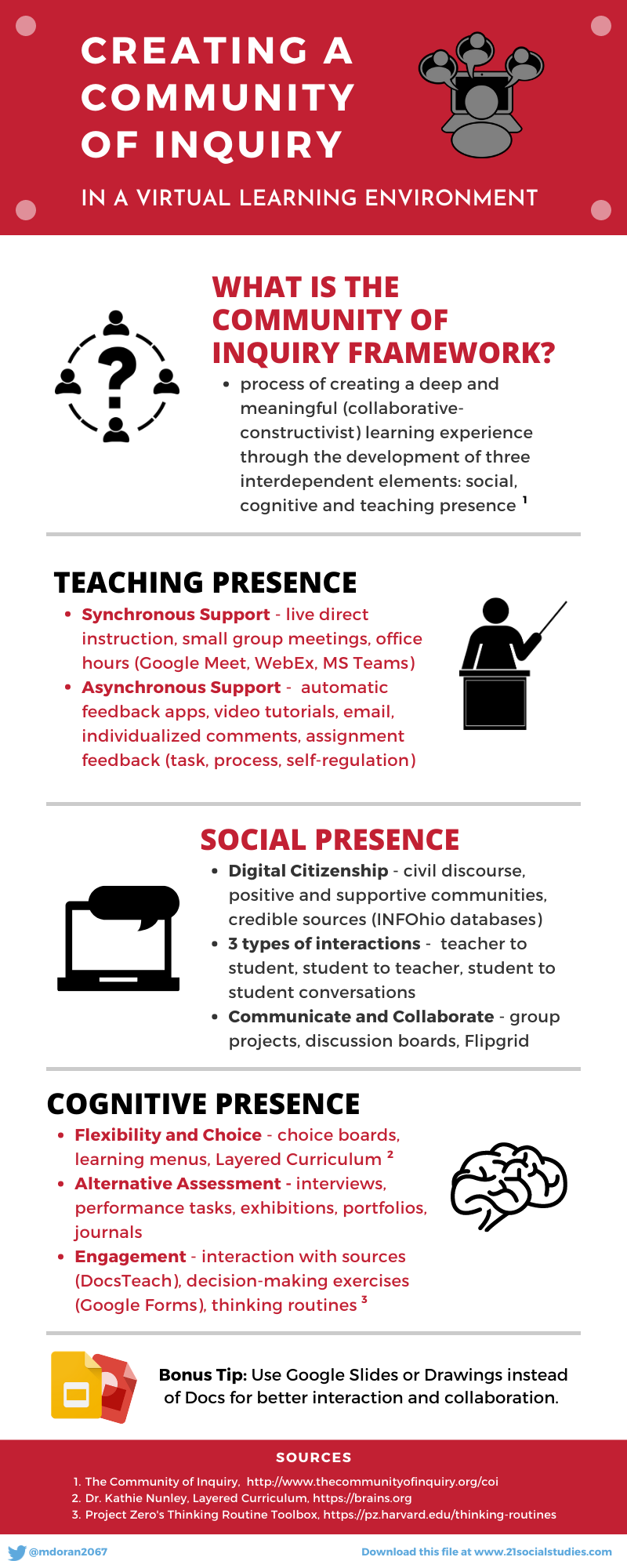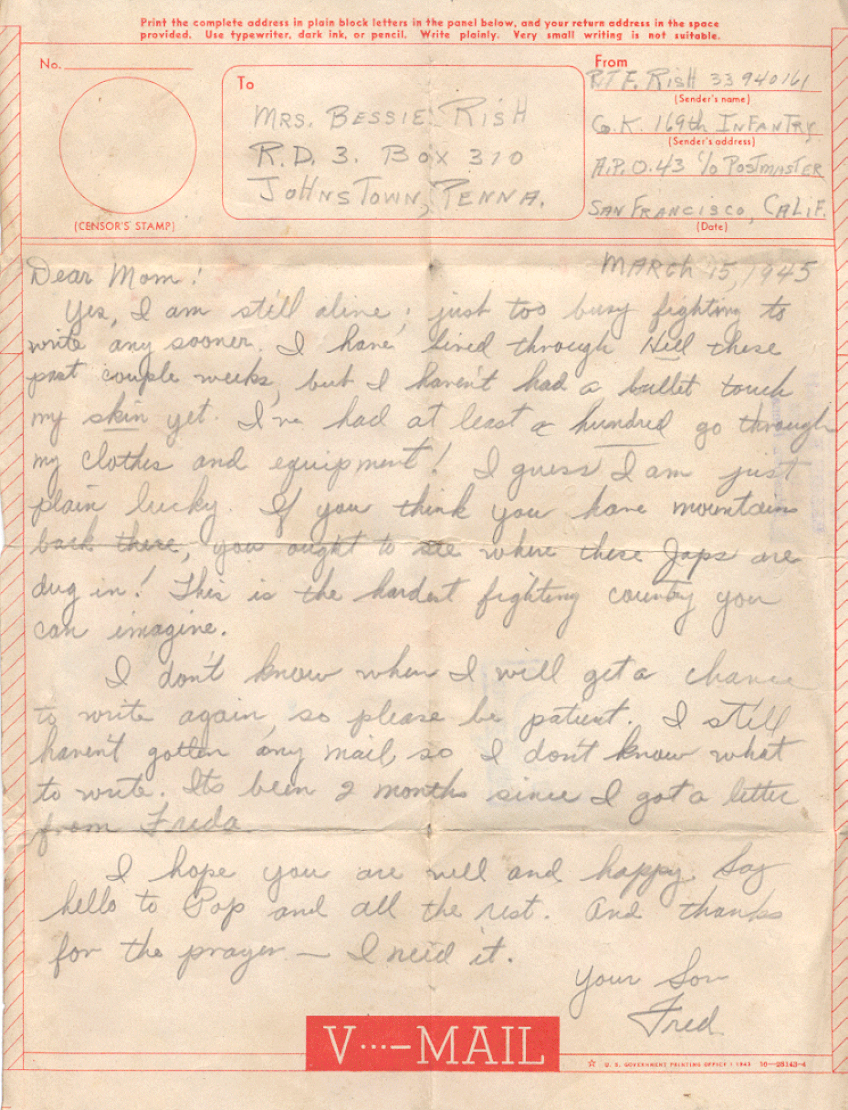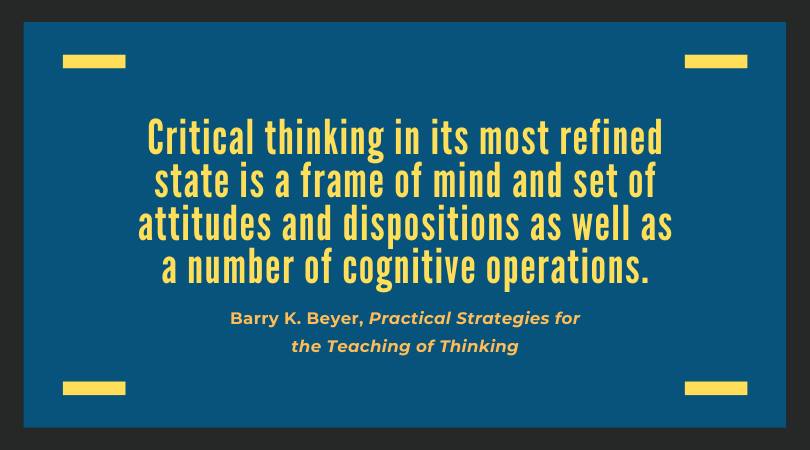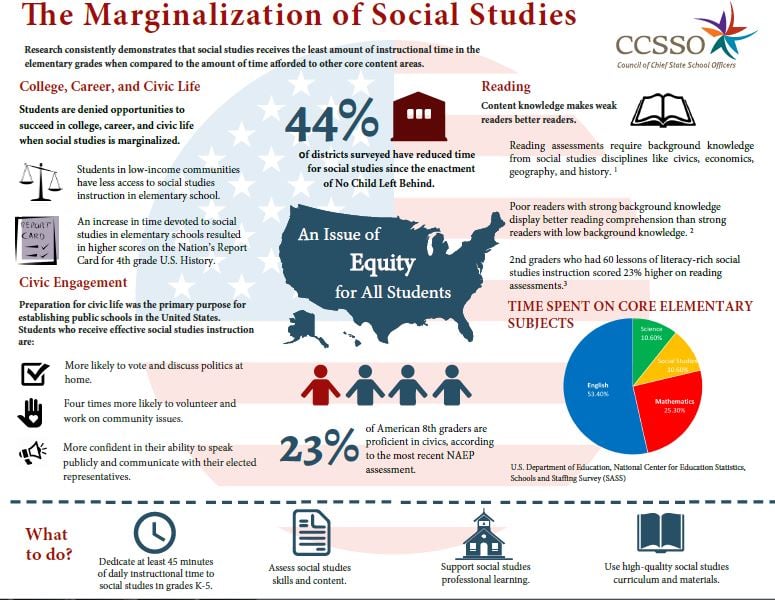Reflections and Collections for the 21st Century Social Studies Classroom
|
By Matt Doran
Like many districts throughout the country, our schools will be starting back in full virtual mode this fall. Using the Community of Inquiry Framework, I have synthesized some best practices for virtual (or blended) learning classrooms in the infographic below. By Matt Doran
What can you do to continue the learning at home during the extended school closure? If you are a social studies teacher or interested parent, you really don’t need the latest temporarily-free app. Instead, pose these three questions:
Watch/read the news and write a daily journal reflection on these questions. When the crisis is over, you will have created a new primary source about this event. Then, go back through history and make connections and comparisons across time and place. Here is a historical look at question 3 since 1958 from the Pew Research Center: Public Trust in Government: 1958-2019. Your students will learn way more from this exercise than filling out digital worksheets. By Matt Doran In times of crisis, history helps us keep things in perspective. Seventy-five years ago, men and women of the Greatest Generation were fighting on the battlefields and working in the factories to defend democracy. Worldwide, more than 15,000,000 soldiers and 45,000,000 civilians died. My maternal grandfather, Pfc. Fred Rish, wrote these words on March 15, 1945 from the Philippines: Dear Mom: Read the full collection of letters at WarMemory.com. 1/3/2020 On ChronologyBy Matt Doran
Chronology is a peculiar thing. The television show Wonder Years aired from 1988-1993 and depicted events 20 years earlier—1968-1973. The Arnolds lived in the postwar suburbs. Jack was a Korean War veteran who worked for a defense contractor. Karen was a counterculture hippie. Winnie’s brother died in Vietnam. All of these events seemed so distant at the time. An equivalent show beginning today would depict the years 2000-2005. What would the themes include? 9/11, Iraq, West Wing, flip phones, Hurricane Katrina? These don’t seem so distant. By Matt Doran
Barry Beyer’s works on thinking skills from the 1980s and 1990s still speak to the epistemological challenges of the 21st century. Although the context and application have changed in the social media age, the skills are enduring. Beyer notes that critical thinking involves both cognitive operations and a set of dispositions. These dispositions include an awareness of the need to evaluate information, a willingness to suspend judgement, respect for reason and evidence, and a desire to consider multiple perspectives. These dispositions are essential to information literacy and democratic participation in the present era. A disposition for fact-checking is a necessary precondition for engaging in this practice. We must first be committed to embracing the weight of evidence, regardless of whether it supports our presuppositions. We must be willing to overcome the draw of confirmation bias to arrive at reasoned conclusions. This understanding of critical thinking has important implications for civic education. Learning targets that emphasize knowledge and skills must be accompanied by those that cultivate the necessary dispositions for critical thinking. By Matt Doran The impeachment of Andrew Johnson in 1868, as with all of the Reconstruction Era, provides a good lens for the study of historiography—the history of historical writing/interpretations. How have historians answered the question: Was the impeachment of Andrew Johnson’s justified? Early American history texts presented the Johnson impeachment as an outrageous overreach—part of a broader interpretation in the era of Jim Crow that portrayed Reconstruction as too radical. From David Saville Muzzey, A History of Our Country (1943) Not content with reducing President Johnson to political impotence, the radicals were determined to drive him out of the White House. On the same day (March 2, 1867) that it destroyed the President’s governments in the South by the Reconstruction Act, Congress passed the Tenure of Office Act, which took from him the privilege, exercised by every President since Washington’s day, of dismissing the members of his own cabinet at his pleasure. It was an outrageous measure, designed merely as a trap to catch Johnson in a “violation” of the law and hence furnish a reason for bringing an accusation against him. When, therefore, the President dismissed his Secretary of War Stanton, who was a virtual spy in the cabinet in close alliance with the radicals in Congress, the House of Representatives impeached Johnson of “high crimes and misdemeanors.” The Senate tried the case from March 30 to May 26, 1868; but in spite of the frantic efforts the radicals to secure a conviction, seven Republican Senators were honorable enough to place justice before partisan hatred and vote with the twelve Democrats for the President’s acquittal, making the vote (35 to 19) fall one short of the two thirds necessary for conviction. By this narrow margin the country was saved from the disgrace of using a clause of the Constitution as a weapon of personal and political vengeance against the highest officer of the land. From Samuel Eliot Morrison, The Oxford History of the American People (1965) The Radical leaders of the Republican party, not content with establishing party ascendancy in the South, aimed at capturing the federal government under the guise of putting the presidency under wraps. By a series of usurpations they intended to make the majority in Congress the ultimate judge of its own powers, and the President a mere chairmen of a cabinet responsible to Congress, as the British cabinet is to the House of Commons. An opening move in this game was the Tenure of Office Act of March 1867 which made it impossible for the President to control his administration, by requiring him to obtain the advice and consent of the Senate for removals as well as appointments to office. The next move to dispose of John by impeachment, so that Radical Ben Wade, president pro-tem of the Senate, would succeed to his office and title. In the wake of the civil rights movement in the 1960s and 1970s, historians challenged traditional Reconstruction interpretations. Writing during the height of the Watergate investigation in 1973, Michael Les Benedict argued that impeachment was a legitimate response to Johnson’s efforts to undermine Reconstruction. From Michael Les Benedict, "The Impeachment Precedent," New York Times (1973) Andrew Johnson, however, was not nearly so innocent a victim. After the war, he arrogated to himself the entire responsibility for restoring civil government in the South—under his inherent war powers as Commander in Chief, he claimed—and denied that Congress had any authority in the premises. . . . Like Benedict, Eric Foner has shown little sympathy for Andrew Johnson in his four decades of writing on Reconstruction. From Eric Foner, The Fiery Trial: Abraham Lincoln and American Slavery (2010). Andrew Johnson was self-absorbed, insensitive to the opinions of others, unwilling to compromise, and unalterably racist. If anyone was responsible for the downfall of his presidency it was Johnson himself. With Congress out of session until December 1865, Johnson took it upon himself to bring about Reconstruction, establishing new governments in the South in which blacks had no voice whatever. When these governments sought to reduce the freedpeople to a situation reminiscent of slavery, he refused to heed the rising tide of Northern concern or to budge from his policy. As a result, Congress, after attempting to work with the President, felt it had no choice but to sweep aside Johnson's Reconstruction plan and to enact some of the most momentous measures in American history: the Civil Rights Act of 1866, which accorded blacks equality before the law; the 14th Amendment, which put the principle of equality unbounded by race into the Constitution; the Reconstruction Act of 1867, which mandated the establishment of new governments in the South with black men, for the first time in our history, enjoying a share of political power. Johnson did everything in his power to obstruct their implementation in 1868. Fed up with his intransigence and incompetence, the House of Representatives impeached Johnson and he came within one vote of conviction by the Senate. by Matt Doran
If we want to find enduring relevance in education, we must draw from the deep cultural foundations of history and philosophy, not economic and business principles. Education is a social institution with a civic mission. It's not enough to define what we want students to know and be able to do. We must also wrestle with the question: What do we want to students to value? College and Career Readiness is a necessary, but not a sufficient mission for schools. A more comprehensive vision needs to include College, Career, and Civic Life Readiness. The Campaign for the Civic Mission of Schools defines civic dispositions as a concern for others' rights and welfare, fairness, reasonable levels of trust, and a sense of public duty. Civic dispositions are crucial to democratic character formation, and the sustainability and improvement of constitutional democracy. If standards must drive our work, then we need a set of civic anchor standards to match those that define critical knowledge and skills. One good option is to pair some of the indicators from the C3 Framework with the Social Justice Standards from Teaching Tolerance. From the C3 Framework: Dimension 2. Civics: Participation and Deliberation: Applying Civic Virtues and Democratic Principles
Dimension 4. Taking Informed Action
From the Teaching Tolerance Social Justice Standards: Identity Anchor Standards
Diversity Anchor Standards
Justice Anchor Standards
Action Anchor Standards
By Matt Doran Those who believe the directive to focus on literacy requires less attention to social studies have failed to understand literacy or social studies. It is true that reading skills help students in other content areas. But the converse is also true: A content-rich curriculum provides the necessary vocabulary and context for successful reading comprehension. The Council of Chief State School Officers has summarized the importance of social studies in the elementary grades. Nell Duke, Professor of Education at the University of Michigan, explains the importance of teaching Social Studies and Science in the elementary grades. 7/18/2019 On Cognitive DissonanceBy Matt Doran My social media posts typically fall well behind the news cycle (if they even make to publication). Rather than retweeting and linking to articles about the issue du jour, I try to use social media platforms in educative ways that promote contemplation and reflection. One question many have recently asked: How is it that seemingly decent people justify and rationalize fundamentally deplorable policies and leaders? The psychological phenomenon of cognitive dissonance helps us understand why individuals will often "explain away" the indefensible. Cognitive dissonance refers the mental discomfort that results from contradictory beliefs, or when our beliefs run contrary to our behaviors (especially in light of new evidence). We seek consistency in our attitudes and perceptions. When what we believe is challenged, something must change in order to reduce the dissonance (lack of agreement). The need for dissonance reduction is especially acute when it involves beliefs about the self. Everyone wants to believe they are fundamentally good people who make good decisions (about health, finances, politics, etc). But sometimes the evidence mounts against us. In government and politics, this happens when parties and leaders engage in actions and policies that violate clear moral and ethical boundaries. To reduce the dissonance, supporters must change a belief--either I'm not so good at making decisions after all, or the actions/policies are justified. Aesop's fable, the Fox and the Grapes, helps illustrate cognitive dissonance. The Fox noticed a beautiful bunch of ripe grapes hanging from a high vine. After multiple attempts to jump for the grapes, the Fox fell short. He finally concludes that the sour grapes are not worth it after all. Clearly, the Fox believed two things: the grapes are desirable and he had the ability to reach them. But when the evidence showed the falsity of his belief about himself, the Fox reduces the dissonance by rationalizing that the grapes really aren't so desirable. Here's a good explanation of cognitive dissonance: https://www.verywellmind.com/what-is-cognitive-dissonance-2795012 7/11/2019 Wineburg on Media LiteracyFrom Why Learn History (When It's Already on Your Phone) by Sam Wineburg. "Wedging a media literacy course into an already crammed curriculum is like slapping a new coat of paint on a house that's teetering on its foundation: it lends to better street appeal but it does little to address the underlying problem. Making headway will entail more than a four-week media or news literacy course. It will require a fundamental reorientation to the curriculum. . . . What once fell on the shoulders of editors, publishers, librarians, and subject matter experts now falls on the shoulders of each and every one of us. The big problem with this new reality is that the ill-informed hold just as much power at the polling station as the well-informed. Reliable information is to civic intelligence what clean air and water are to public health. . . . Jefferson's solution is no less apt today than it was in his era. 'If we think [the people] are not enlightened enough to exercise their control with a wholesome discretion, the remedy is not take it from them, but to inform their discretion by education.'" - Sam Wineburg |
Blog Categories
All
Blog Archives
August 2020
|




 RSS Feed
RSS Feed

8/1/2020
0 Comments